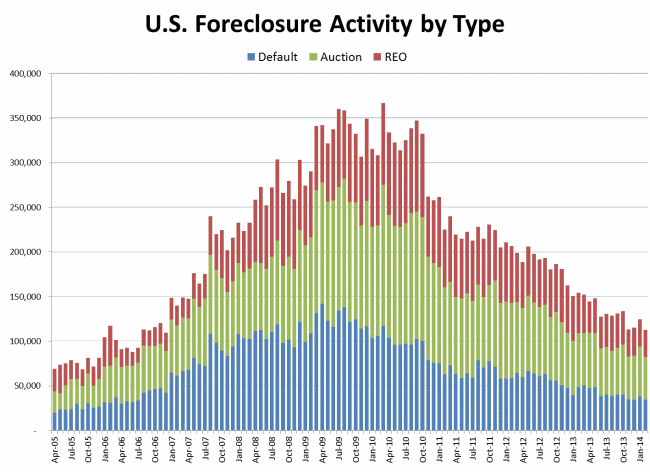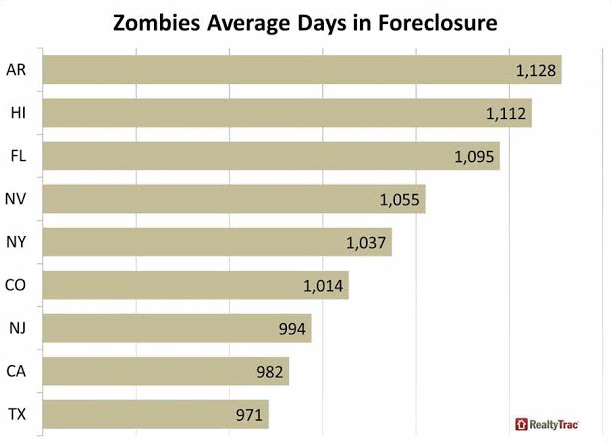Blog

After Rising Last Month, Foreclosures Snap Back to 8 Year Low
Afterrnspiking 8 percent in January, foreclosures filings have resumed their downwardrnspiral RealtyTrac said today. Its U.S.rnForeclosure Market Report for February notes that filings, including defaultrnnotices, scheduled auctions, and bank repossessions or completed foreclosures,rndecreased by 10 percent from January and were 27 percent below levels one yearrnearlier. There were a total of 112,498rnfilings during the month, the lowest monthly total since December 2006. </p
 </p
</p
Foreclosurernstarts, which increased 10 percent in January retreated 9 percent in Februaryrnto a total of 51,842, a 98 month low and 27 percent lower than in Februaryrn2013. Foreclosure auctions werernscheduled for the first time on 47,715 properties, down 15 percent from thernprevious month and 21 percent from a year earlier. Bank repossessions (REO) rose less than 1rnpercent from January to 30,307 but this was 33 percent below the completed foreclosuresrnin February 2013. </p
There were states that ran counterrnto each of the national trends but it was not necessarily the same states seeingrnincreases in all categories. Nineteenrnstates had higher numbers of scheduled auctions than a year earlier with Oregonrnjumping 389 percent and Utah and Connecticut each up over 140 percent. Connecticut was among the 15 statesrnwith an increase in REO as well, jumping 162 percent, along with New York (108rnpercent), Maryland (98 percent), and New Jersey (90 percent). New Jersey also had the largest increase inrnforeclosure starts with 126 percent more in February 2014 than in Februaryrn2013.</p
States with the highest foreclosurernrates in February were Florida, Maryland, and Nevada. But while Florida andrnNevada remain on a downward trajectory, Maryland continues to increase. It is now in second place nationally with arnfiling for one in every 557 housing units after activity increased in Februaryrnfor the 20th consecutive month. rnOn a year-over-year basis, Maryland foreclosure starts increased 15rnpercent, scheduled foreclosure auctions increased 36 percent, and bankrnrepossessions increased 98 percent.</p
Florida remains the most activernstate for foreclosure filings with one in every 372 households affected. However, February marked the 12th</supconsecutive monthly drop in foreclosure starts and the sixth for decreases inrnbank repossessions. Scheduled auctionsrndecreased 2 percent on an annual basis in February after increasing for 13rnstraight months.</p
Nevada’s activity also continued tornfall, decreasing 16 percent month over month and 49 percent from the previousrnyear. The state still posted the nation’srnthird highest foreclosure rate – one in every 633 housing units with arnforeclosure filing. </p
Other states in the top five forrnforeclosure activity were New Jersey and Illinois. NewrnJersey had a filing on one in every 739 housing units, Illinois on one in 811.</p
Nine of the top 10 metro foreclosurernrates in February were posted by cities in Florida, along with Atlantic City,rnN.J., where overall foreclosure activity increased 254 percent from a year ago.</p
The RealtyTrac report also includedrnupdated information on what it calls zombie foreclosures, properties that werernleft vacant by the distressed homeowners. rnThe company estimated that 152,033 properties, 21 percent of allrnproperties in foreclosure, had been abandoned as of the first quarter ofrn2014. This does not include vacantrnbank-owned properties. The propertiesrnhad been in the foreclosure process an average of 1,031 days.</p
The number of zombie foreclosuresrnnationwide did not change substantially from RealtyTrac’s report in the thirdrnquarter of 2013, but some states saw substantial increases in owner-vacatedrnproperties. They increased 27 percent inrnMichigan, 14 percent in New Jersey, and 21 percent in Nevada. The largest number of such abandonedrnproperties were in Florida, which houses almost 55,000 of them, Illinois, NewrnYork, and New Jersey. States with thernlongest average time in foreclosure for owner-vacated foreclosures includedrnArkansas (1,128 days), Hawaii (1,112 days), Florida (1,095 days), Nevada (1,055rndays), and New York (1,037 days).</p
 </p
</p
“Cold weather and a shortrnmonth certainly contributed to a seasonal drop in foreclosure activity inrnFebruary, but the reality is that new activity is no longer the biggest threatrnto the housing market when it comes to foreclosures,” said Daren Blomquist,rnvice president at RealtyTrac. “The biggest threat from foreclosures goingrnforward is properties that have been lingering in the foreclosure process forrnyears, many of them vacant with neither the distressed homeowner or thernforeclosing lender taking responsibility for maintenance and upkeep of the homern- or at the very least facilitating a sale to a new homeowner more likely tornperform needed upkeep and maintenance.</p
“One in every five homes inrnthe foreclosure process nationwide have been vacated by the distressedrnhomeowner, but it is closer to one in three foreclosures in some cities,”rnBlomquist added. “These properties drag down home values in the surroundingrnneighborhood and contribute to a climate of uncertainty and low inventory inrnlocal housing markets.”
All Content Copyright © 2003 – 2009 Brown House Media, Inc. All Rights Reserved.nReproduction in any form without permission of MortgageNewsDaily.com is prohibited.
Latest Articles
By John Gittelsohn August 24, 2020, 4:00 AM PDT Some of the largest real estate investors are walking away from Read More...
Late-Stage Delinquencies are SurgingAug 21 2020, 11:59AM Like the report from Black Knight earlier today, the second quarter National Delinquency Survey from the Read More...
Published by the Federal Reserve Bank of San FranciscoIt was recently published by the Federal Reserve Bank of San Francisco, which is about as official as you can Read More...

Comments
Leave a Comment